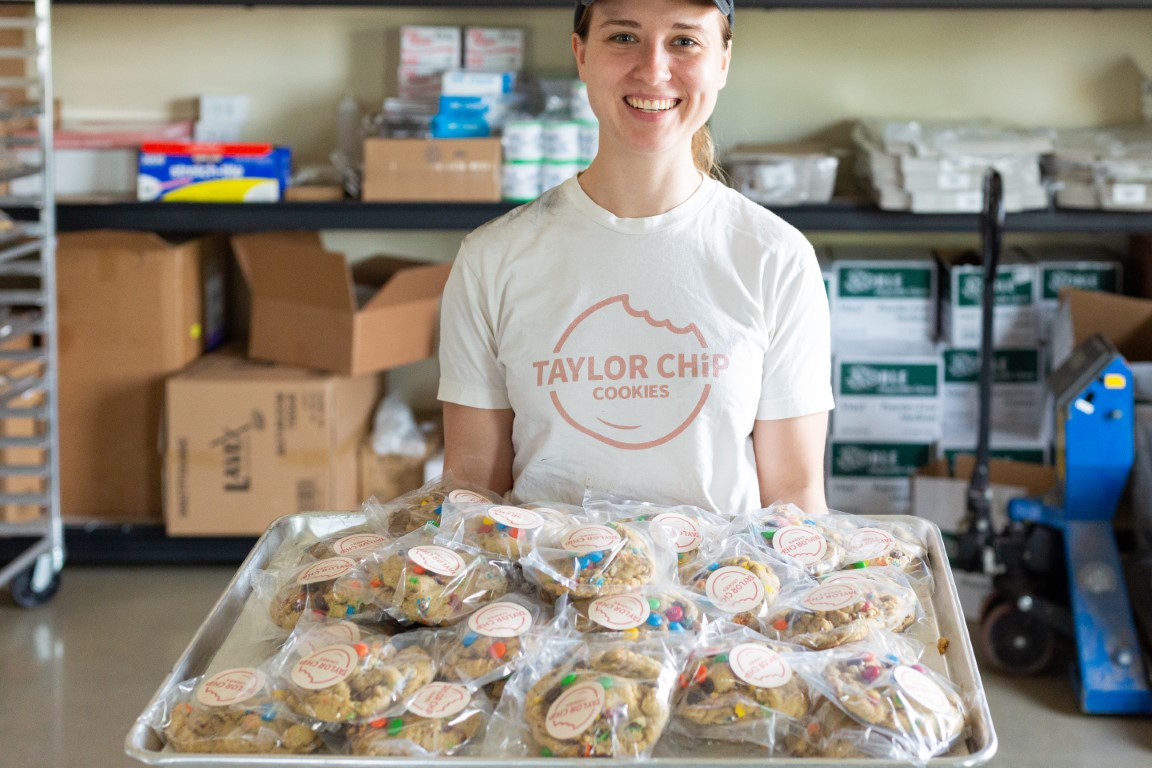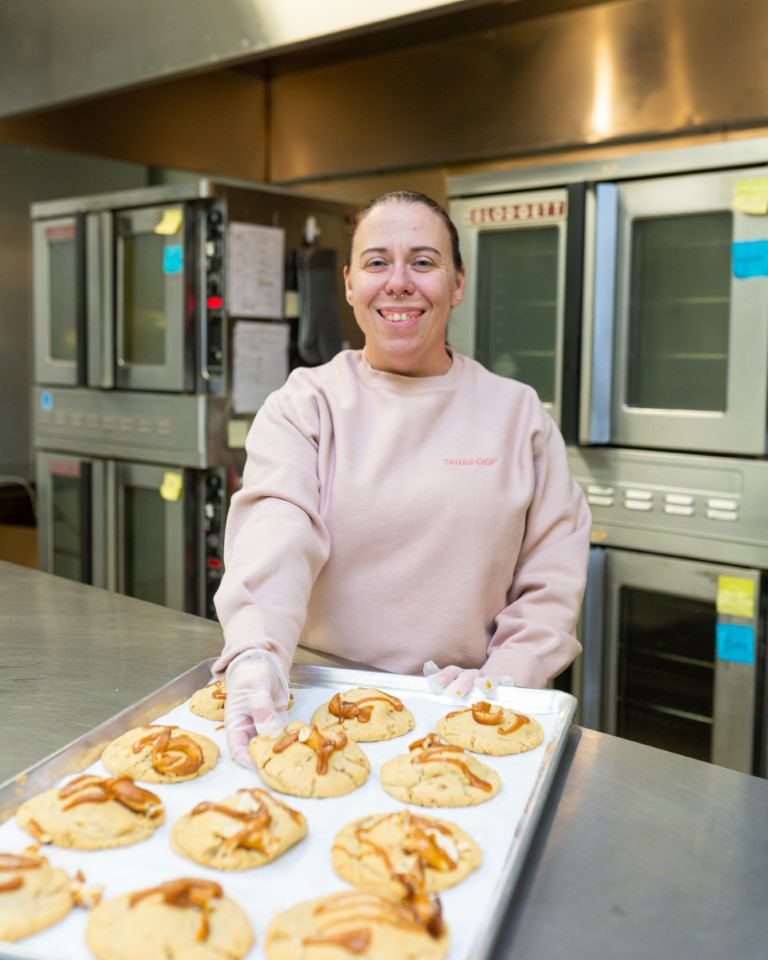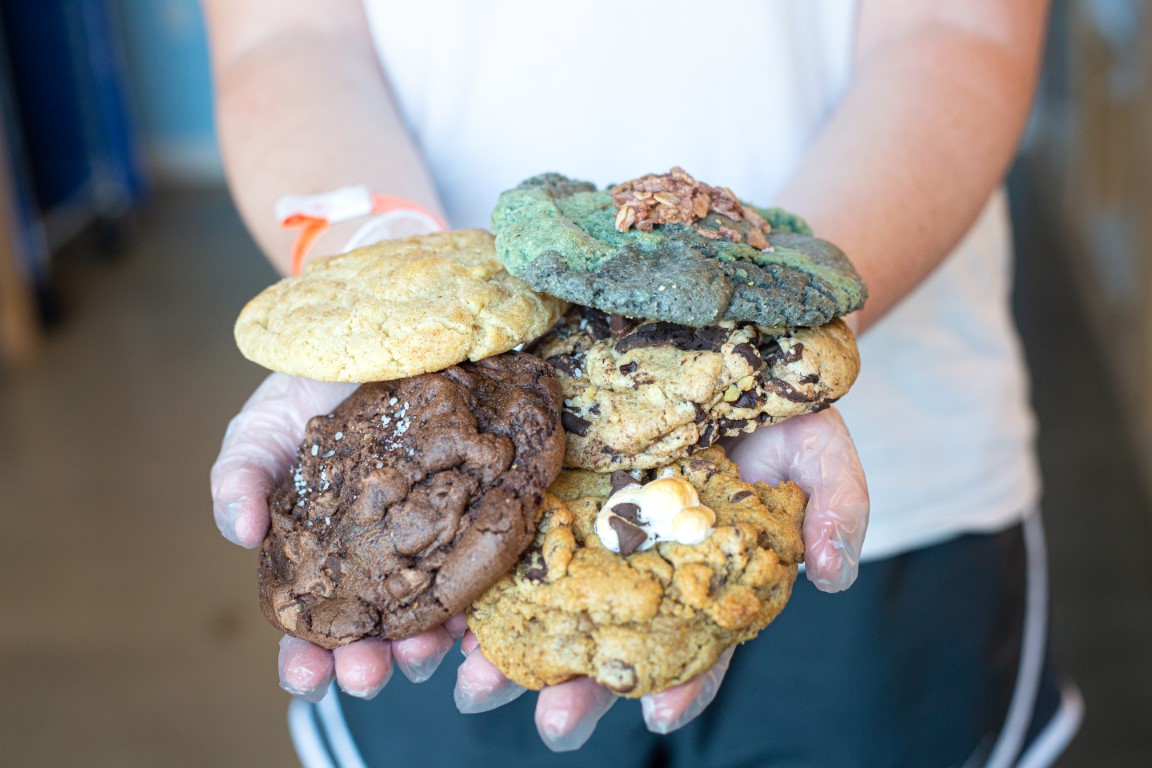When choosing between a baking sheet and a cookie sheet, consider their unique features and purposes. Baking sheets, with rimmed edges, are perfect for preventing spills and are versatile enough for roasting vegetables or baking pastries. Conversely, cookie sheets are rimless, guaranteeing easy cookie removal and even browning, ideal for delicate pastries. Materials also matter; aluminum heats evenly, while stainless steel offers durability despite uneven heat distribution. Opt for thicker sheets to resist warping and guarantee consistent cooking. For effective use, follow care instructions diligently and select the sheet type based on specific baking needs and desired outcomes. Explore further for more perspectives.
Key Takeaways
- Baking sheets have rimmed edges, making them suitable for tasks involving liquids, like roasting and baking pastries.
- Cookie sheets feature a rimless design, ideal for easy cookie removal and even browning of baked goods.
- Aluminum baking sheets provide even heat distribution, while stainless steel offers durability but may heat unevenly.
- Thicker baking sheets resist warping and offer consistent cooking, while thinner cookie sheets are designed for quicker tasks.
- Regular hand washing and proper storage extend the lifespan of both baking and cookie sheets.
Understanding Baking Sheets
When you're exploring baking sheets, it's important to understand their key features, such as material, thickness, and design elements like rims or a flat surface, which influence how heat is distributed and can affect baking results. You'll find that popular types, including aluminum, stainless steel, and non-stick varieties, each have their unique uses and benefits, catering to different cooking needs. Additionally, the versatility of baking sheets allows them to serve various cooking applications, from roasting vegetables to baking pastries, making them a fundamental tool in any kitchen.
Key Features and Design Elements
Understanding the key features and design elements of baking sheets can enhance your cooking experience greatly. Baking sheets and cookie sheets might seem similar, but they differ in design. A rimless sheet, often used for cookies, allows easy sliding, while a rimmed baking sheet prevents spills. Nonstick coating on these sheets can simplify cleanup, but be cautious of scratches. Aluminized steel is popular for its durability and even heat distribution. Proper air circulation is essential; therefore, flat edges and the right baking sheet sizes matter. Sheet pans typically come in various sizes, accommodating different needs. Whether you're baking cookies or roasting vegetables, understanding these elements helps you choose the right tool, ensuring your culinary creations come out perfectly every time.
Popular Types and Their Uses
Dive into the domain of baking sheets, and you'll reveal a variety of types designed for specific culinary tasks. When baking cookies, nonstick baking sheets are a popular choice due to their effortless release, thanks to the nonstick surface. Rimless cookie sheets are ideal for baking delicate cookies, allowing them to slide off smoothly. Understanding types of sheet pans aids in selecting the right tool for your baking needs. Baking sheet pans come in various cookie sheet sizes, offering flexibility when preparing large batches of cookies. It's essential to take into account the oven temperature, as some materials withstand heat better. Whether you're a seasoned baker or a novice, knowing these details guarantees your baking efforts are successful and efficient.
Versatility in Cooking Applications
Beyond just baking cookies, baking sheets offer remarkable versatility in cooking applications, making them indispensable in any kitchen. You can employ them for a wide array of tasks, from roasting vegetables to preparing sheet-pan dinners. Their flat design and available rimmed sheet pans make them a versatile option for many cooking tasks. Here are some ways to make use of them:
-
Baking Pans: Use them with parchment paper or a silicone baking mat to prevent sticking and guarantee even cooking of savory food items.
-
Nonstick Options: Opt for nonstick options to simplify the cleaning process and expand your cooking possibilities.
-
Temperature Range: Baking sheets can withstand a broad temperature range, allowing you to experiment with different cooking techniques and recipes.
Incorporating these elements will maximize your baking sheet's potential.
Understanding Cookie Sheets
When you're examining cookie sheets, you'll notice their distinctive features and construction set them apart from other baking tools. These sheets are typically made from materials like aluminum or stainless steel, each of which impacts heat distribution and baking results differently. Understanding their specific uses and limitations will help you make the right choice for your baking needs, ensuring your cookies come out just right every time.
Distinctive Features and Construction
In the area of baking, understanding the distinctive features and construction of cookie sheets can enhance your baking game. Cookie sheets differ from baking sheets and jelly roll pans in several ways. They typically have a flat surface without edges, which facilitates even heat conduction and results in perfectly baked cookies. Here are some key features of cookie sheets:
- Material: Traditional cookie sheets may be made from stainless steel or other metals, offering durability and consistent heat distribution.
- Design: Unlike baking sheets, cookie sheets often lack edges, allowing for easy removal of baked goods.
- Coatings: Many come with a nonstick coating or layer, which prevents sticking and simplifies cleanup.
Choosing the right cookie sheet can improve your baking experience markedly.
Material Types and Their Impact
Understanding the various material types of cookie sheets can greatly impact your baking results. When selecting a cookie sheet, consider options like uncoated aluminum, which heats evenly and is ideal for browning. A stainless steel cookie sheet offers durability but may not distribute heat as uniformly. For those concerned about sticky food items, a nonstick-coated cookie sheet with a silicone nonstick coating or ceramic coating can be beneficial, preventing food from sticking and making cleanup easier. Thicker metal sheets are also available, which resist warping and offer better heat distribution. Each material disperses heat differently, affecting how your cookies bake. When comparing cookie sheets to a baking sheet, remember that the material choice directly influences cooking times and outcomes.
Specific Uses and Limitations
Why choose one type of cookie sheet over another? Understanding the specific uses and limitations of different sheets can enhance your baking experience. For instance, a nonstick cookie sheet offers a smooth surface that's ideal for delicate foods, such as cookies that might crumble or break. However, it can have limitations like uneven browning. On the other hand, a heavy-duty aluminum sheet pan provides even heat distribution but may require parchment paper to prevent stuck-on food.
Consider these options:
- Nonstick Sheets: Great for delicate foods but can cause uneven browning.
- Heavy-Duty Aluminum Sheet Pan: Guarantees even baking, yet non-coated surfaces might need parchment paper.
- Baking Sheets with Smooth Surfaces: Prevents sticking but may not handle high temperatures well.
Each type serves its purpose, so choose wisely based on your baking needs.
Key Differences and Applications
When comparing baking sheets and cookie sheets, you'll notice distinct design differences that affect their performance in various recipes. Baking sheets usually have raised edges, providing better heat distribution and temperature response, making them ideal for roasting vegetables or baking items that release juices. In contrast, cookie sheets typically feature flat edges for easier cookie removal and consistent browning, ensuring your baked goods turn out perfectly every time.
Design Comparison
Baking sheets and cookie sheets might seem interchangeable, but they have distinct design differences that influence their applications. When comparing a baking sheet to a cookie sheet, consider the following:
-
Gauge Range: Baking sheets typically offer a wider gauge range, making them sturdier for various uses, while cookie sheets are often thinner, ideal for quick bakes.
-
Design Features: Baking sheets often have a steel rim to prevent spills, while cookie sheets may have a corrugated surface for better airflow, enhancing browning.
-
Versatility: Baking sheets are a versatile piece in your kitchen; they're durable for metal utensils and work well with nonstick cooking spray. They also come in a variety of sheet sizes to accommodate different recipes.
These factors are essential in the design comparison between baking and cookie sheets.
Performance in Different Recipes
Whether you're a seasoned baker or just starting out, understanding how baking sheets and cookie sheets perform with different recipes can enhance your culinary creations. When baking cookie dough, coated cookie sheets help achieve evenly browned bottoms, while a sheet with parchment paper prevents sticking. For corrugated-bottom cookies, the texture is often more defined on a baking sheet. If you're working with extreme heat or ceramic nonstick coating, it's essential to use a non-abrasive sponge for cleaning. Baking sheets are versatile for savory recipes, absorbing and retaining flavors well. Meanwhile, cookie sheets excel with your favorite recipes that require uniform heat distribution, like cookies. Knowing these differences helps you choose the right tool, ensuring each recipe turns out perfectly.
Temperature Response and Heat Distribution
Understanding how baking sheets and cookie sheets respond to temperature and distribute heat can greatly impact your baking results. Baking sheets, usually made from heavier gauge material and often with layers of metal, offer even heat distribution, ensuring your baked goods have crisp edges and consistent cooking. Cookie sheets, especially those that are uncoated, provide a direct surface for baking, which can lead to faster temperature response but may require more careful monitoring.
Consider these key points:
- Heavier Gauge: Baking sheets often use heavier gauge materials, providing stability and support for extensive baking in a bakery-depth oven.
- Perfect Size: The size of your sheet can affect how heat is distributed; choose the perfect size for your recipe.
- Crisp Edges: Opt for uncoated baking sheets for crispier results, as they react quickly to temperature changes.
Making the Right Choice
When deciding between a baking sheet and a cookie sheet, you should consider your recipe requirements, as each tool offers distinct advantages tailored to specific baking needs. For professional bakers, investing in durable sheets might be essential for consistent, high-quality results, while home bakers might prioritize versatility and ease of use. Additionally, think about the long-term benefits and durability of the sheets, as a well-chosen tool can enhance your baking experience and yield better results over time.
Matching Tools to Recipe Requirements
Choosing the right baking tool can make a considerable difference in your recipe's outcome. Whether you're preparing a sheet cake or baking dozens of cookies, understanding the specifics of each tool is essential. Baking sheets, often found in professional kitchens, offer uniform sizes and are perfect for tasks requiring full-size sheet pans, like delicate cakes or sheet trays. On the other hand, cookie sheets are designed for ideal airflow, making them ideal for cookies.
Here's how to match tools to your recipe requirements:
- Baking Sheet: Best for large batches and uniform results; add silicone liners for delicate cakes.
- Cookie Sheet: Perfect for baking dozens of cookies with even browning.
- Full-size Sheet Pans: Suitable for professional kitchens, offering consistent heat distribution.
Choose wisely to guarantee your baked goods turn out perfectly every time.
Professional vs Home Baking Needs
In both professional and home kitchens, selecting the appropriate baking tools can greatly impact your results. Commercial kitchens often require full-size baking sheets to handle large volumes of food prep, as these are essential kitchen tools for efficiency. For home bakers, standard size or quarter sheet pans are more practical, fitting better in standard ovens while still offering versatility. You might bake sugar cookies or prepare sheet pan meals with ease using these options. The type of sheet tray you choose should match your specific baking and cooking needs. Whether you're using a hot oven in a bustling commercial environment or a cozy home kitchen, selecting the right sheet guarantees peak performance and results for every culinary undertaking.
Investment and Durability Considerations
Longevity is a key factor to evaluate in the investment and durability of baking sheets and cookie sheets. When selecting kitchen gear, consider how often you'll use it and for what purpose. A heavy gauge, half-size sheet pan might be perfect for frequent bakers, ensuring even heat distribution and lasting quality. Meanwhile, an inexpensive sheet may suffice for occasional use but could lead to dingy baking sheets over time.
To make the right choice, consider these points:
- Material: Opt for heavy gauge pans to withstand frequent use and avoid warping.
- Size: A quarter-sheet pan is ideal for small batches, while full sheets suit larger needs.
- Maintenance: Clean with warm water to extend the life of your favorite cookie sheet.
Care and Maintenance
To keep your baking and cookie sheets in top condition, start by using the right cleaning methods, such as hand washing with mild soap and a soft sponge to avoid scratches. Proper storage is essential; consider stacking them with a protective layer between each sheet to prevent warping and scratches. Following these steps not only helps maintain their appearance but also extends their lifespan, ensuring you get the most out of your kitchen essentials.
Proper Cleaning Methods
When it comes to keeping your baking and cookie sheets in top shape, everyone should know that proper cleaning is key. Start by washing them in warm, soapy water, which effectively removes grease and food particles. Rinse with cold water to guarantee no soap residue remains. Avoid scrubbing too hard, especially on thinner sheets, to prevent damage to the base metals. Here are a few tips for maintaining your sheets:
- Avoid Acidic Foods: They can react with metals, damaging the sheet's surface.
- Use a Layer of Aluminum or Parchment: Protect your sheets when baking average-sized cookies or roasted potatoes, keeping the bottoms of cookies from sticking.
- Rotate Sheets: Use different sheets for different tasks, like baking or roasting, to prolong their life.
Storage Best Practices
Proper cleaning is just one part of maintaining your baking and cookie sheets, but knowing how to store them correctly guarantees they last even longer. After drying, stack your cookie sheets, organizing by common sizes such as quarter sheets and eighth sheets. Using a sheet of wax paper between each assures they don't stick together or scratch. For smaller sheets, like those used in toaster ovens, this method works well. Place your muffin pans upright, so they don't take up plenty of surface area. When stacking, leave room to easily access your sheets for baking a batch of cookies. Keeping your baking tools accessible helps you efficiently whip up dozens of cookies whenever needed, enhancing your baking experience and extending your tools' life.
Extending Lifespan Tips
While taking care of your baking and cookie sheets might seem tedious, it greatly extends their lifespan. Proper maintenance guarantees you won't be constantly replacing dozens of cookie sheets. Here's how to keep them in top shape:
-
Clean Gently: Avoid abrasive scrubbers that can damage the surface. Instead, soak them in warm, soapy water and use a soft sponge to remove residue from jelly rolls and sponge cakes.
-
Avoid High Heat: Excessive heat can warp your pans, especially the thinner jelly-roll pan. Stick to recommended temperatures, usually listed on the packaging or at grocery stores.
-
Store Properly: Keep cookie sheets flat to prevent size wear or bending. Understanding the difference between cookie sheets and fluffy sheets helps in storing them correctly, preserving their shape.
Our Journey to Baking Perfection
At Taylor Chip, our passion for baking isn't just a business—it's a love story. Since 2015, we've been on a journey to perfect the art of baking, particularly when it comes to cookies. What started as a fun date night activity for us, Sara and Dougie, quickly evolved into an obsession with creating the perfect cookie. Over the course of a year, we dedicated ourselves to honing our baking skills, experimenting with various techniques, ingredients, and tools.
Our commitment to excellence in baking has given us unique insights into the nuances of baking sheets and cookie sheets. We've tested countless varieties, from rimmed baking sheets for our more adventurous recipes to flat cookie sheets for achieving that perfect golden-brown cookie. This hands-on experience has taught us the importance of choosing the right tool for each baking task. We understand firsthand how the type of sheet you use can significantly impact the outcome of your baked goods, whether you're aiming for crispy edges, even browning, or preventing spread.
Our journey from baking enthusiasts to cookie perfectionists has equipped us with practical knowledge that we're excited to share with fellow baking enthusiasts and home cooks alike.
Frequently Asked Questions
Can Baking Sheets Be Used for Roasting Vegetables?
Yes, you can use baking sheets for roasting vegetables. They distribute heat evenly, ensuring your veggies cook properly. Just toss them with oil and seasonings, spread them out, and roast until they're golden and delicious. Enjoy!
Are There Health Concerns With Non-Stick Coatings on Baking Sheets?
You're right to be cautious. Non-stick coatings can release harmful chemicals if overheated. To minimize risks, keep the temperature below 500°F, avoid scratching the surface, and consider using uncoated or silicone-lined sheets for healthier cooking.
How Do Baking Sheets Affect Cooking Time Compared to Cookie Sheets?
You need to know that different sheets impact cooking time. Baking sheets, being thicker, may take longer to heat up, while cookie sheets heat quicker. Adjust your timing to guarantee your treats bake perfectly every time.
What's the Best Way to Prevent Cookies From Spreading Too Much?
To prevent your cookies from spreading too much, chill the dough for at least 30 minutes. Use parchment paper on your baking sheet, and make certain you're using the right amount of flour for the dough's consistency.
Can You Use Parchment Paper on Both Baking and Cookie Sheets?
Yes, you can use parchment paper on both types of sheets. It prevents sticking and makes cleanup easier. Just make sure it's securely placed, so it doesn't slide around when you're baking or moving the sheets.
Conclusion
In choosing between baking sheets and cookie sheets, you should consider your specific baking needs, taking into account each tool's unique characteristics. Baking sheets, with their raised edges, are ideal for roasting and baking tasks that require containment of juices. Cookie sheets, on the other hand, offer a flat surface perfect for even baking and easy removal of cookies. Proper care and maintenance, such as hand washing and avoiding harsh abrasives, can extend their lifespan and maintain performance.









